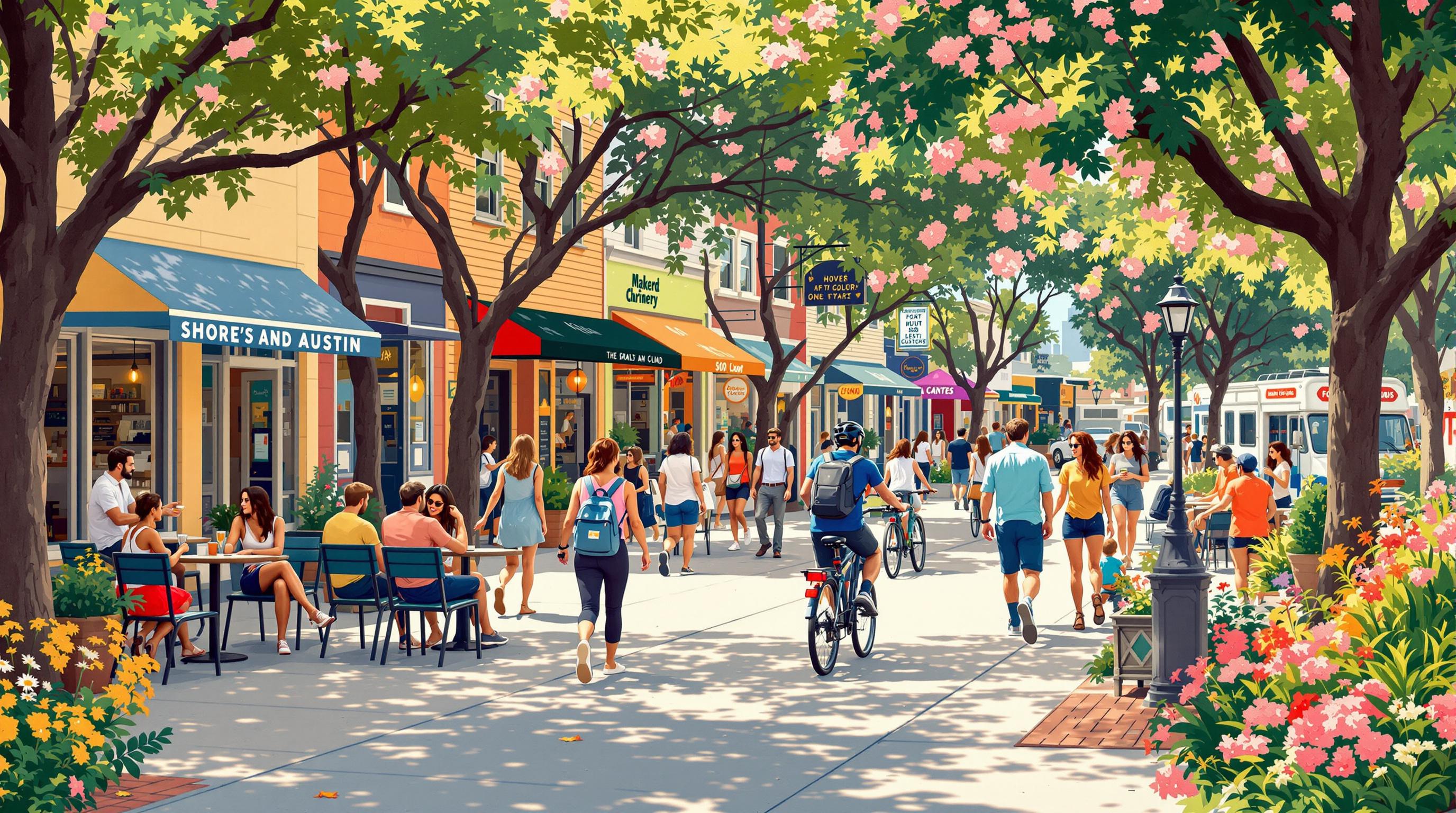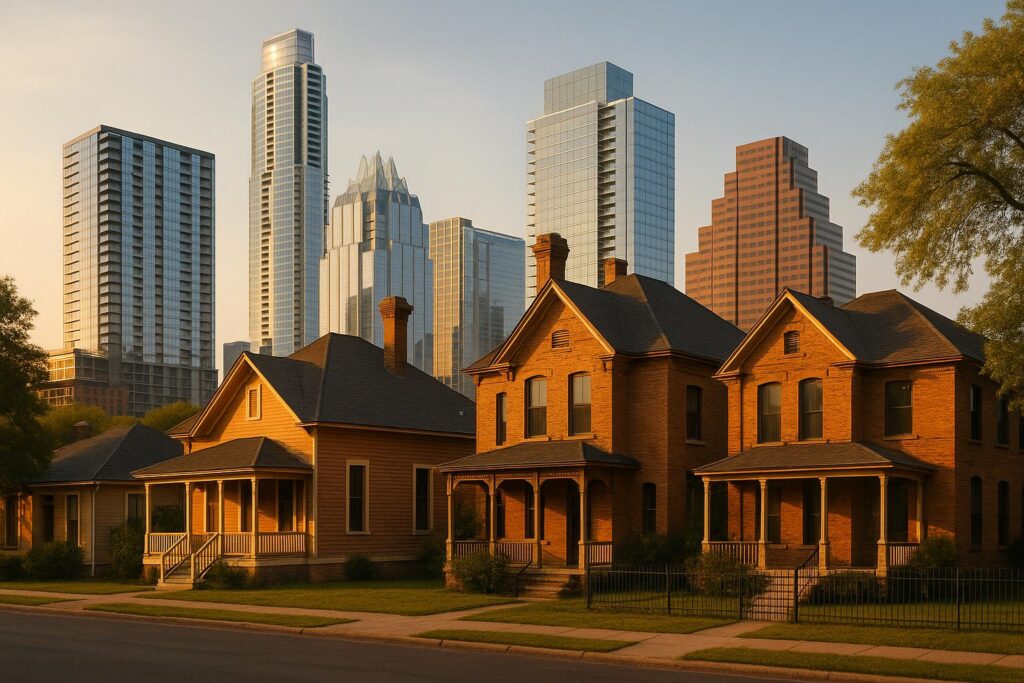Looking for a neighborhood in Austin where you can live, work, and play – all without needing a car? Here’s a quick guide to five of the most walkable areas in the city:
- Downtown Austin: Live music, restaurants, Lady Bird Lake Trail, and a flagship Whole Foods within walking distance.
- South Congress (SoCo): Unique shops, iconic eateries, and a vibrant cultural vibe near Lady Bird Lake.
- East Austin: Historic charm meets trendy spots with local art, food, and easy MetroRail access.
- Hyde Park: Tree-lined streets, historic homes, and a cozy, pedestrian-friendly environment.
- Mueller: Thoughtfully planned community with trails, parks, shops, and sustainable design.
Each neighborhood offers a mix of convenience, community spaces, and easy access to essentials like grocery stores, dining, and entertainment. Whether you prefer the urban buzz of downtown or the family-friendly design of Mueller, Austin’s walkable neighborhoods have something for everyone.
7 Most Walkable Neighborhoods in Austin, Texas | Your Guide …
1. Downtown Austin
Downtown Austin stands out for its walkable layout, offering a mix of spaces for living, working, and relaxing – all without needing a car. Residents can stroll to popular spots like the 6th Street Entertainment District, packed with live music venues, restaurants, and bars, or the 2nd Street District, home to high-end boutiques and dining. This setup makes life convenient and enjoyable for those who prefer getting around on foot.
The area also boasts easy access to key amenities, including a flagship Whole Foods Market, the Republic Square farmers’ market, the Central Library, and the scenic Lady Bird Lake Trail for outdoor activities. Local coffee shops and fitness centers add to the neighborhood’s charm, making it clear why so many Austin locals are drawn to this pedestrian-friendly hub.
2. South Congress (SoCo)
South Congress, or SoCo, is a lively neighborhood that combines historic charm with modern convenience. Stretching along South Congress Avenue, it offers a mix of attractions that make it a favorite destination for both locals and tourists.
The area is home to a variety of unique businesses housed in restored spaces. The Continental Club, a legendary music venue that’s been around since 1955, remains a cornerstone of the local music scene. Jo’s Coffee is another must-visit spot, famous for its welcoming vibe and the iconic "I Love You So Much" mural. For shopping, places like Lucy in Disguise with Diamonds and Allen’s Boots stand out, offering vintage treasures and classic Western wear.
SoCo’s dining scene is just as diverse as its shops. Food lovers can enjoy everything from New York–style slices at Home Slice Pizza to Tex-Mex favorites at Güero’s Taco Bar. For something more upscale, June’s All Day serves elevated dishes in a casual setting.
Outdoor enthusiasts will appreciate the nearby Butler Hike and Bike Trail along Lady Bird Lake, perfect for a relaxing walk or bike ride. The neighborhood also boasts convenient markets like SoCo Market, South Congress H-E-B, and the Sunday SoCo Farmers Market, where you can pick up fresh local produce and everyday essentials.
sbb-itb-4c99469
3. East Austin
East Austin blends historic charm with modern convenience, creating a walkable neighborhood that showcases the true essence of Austin. With a mix of unique homes, thriving local businesses, and cultural hotspots, it’s a favorite for residents and visitors alike.
Wide sidewalks and pedestrian-friendly streets make it easy to explore the area on foot. A nearby MetroRail station connects East Austin to the rest of the city, while East 6th and East 7th Streets offer a variety of restaurants, coffee shops, and entertainment venues just a short stroll away. This setup supports a lively food and drink scene.
Food lovers have plenty to choose from. Franklin Barbecue is famous for its brisket, Suerte serves up flavorful Mexican dishes, and Lazarus Brewing Company combines craft beer with coffee, reflecting the area’s cultural mix.
Art is everywhere in East Austin. The Canopy complex is home to artist studios, galleries, and regular exhibitions. Vibrant murals and street art add a splash of creativity to the neighborhood’s streets, making it a visual treat.
Housing in East Austin is as diverse as its culture. Restored historic bungalows sit alongside sleek modern condos. Mixed-use developments combine living spaces with shops, while cozy single-family homes with inviting front porches are common near Comal Street, encouraging a sense of community.
For outdoor enthusiasts, Edward Rendon Sr. Park at Festival Beach offers green spaces along Lady Bird Lake, and the Southern Walnut Creek Trail is perfect for walking and cycling. The area also features pocket parks, community gardens, and even an urban farm at Boggy Creek Farm.
East Austin’s character is preserved through its long-standing businesses. Cenote, housed in a restored Victorian home, and the historic Scoot Inn, one of Austin’s oldest bars, honor the neighborhood’s roots while embracing its growth into a pedestrian-friendly hub.
4. Hyde Park
Hyde Park stands out as one of Austin’s historic neighborhoods, offering a mix of classic charm and modern convenience. Its tree-lined streets and compact layout make it easy to navigate on foot, with plenty of essential amenities nearby.
The neighborhood is designed with pedestrians in mind. You’ll find well-kept sidewalks, clearly marked crosswalks, and thoughtfully planned streets that make walking both safe and enjoyable. Local parks and community spaces add to the appeal, providing great spots for outdoor activities and neighborhood gatherings.
This combination of history and walkability makes Hyde Park a standout, setting the stage for another walkable gem in Austin.
5. Mueller
Mueller is a prime example of urban planning designed with pedestrians in mind. Located on the 700-acre site of the former Robert Mueller Municipal Airport, the development prioritizes walkability and community living.
The layout includes over 13 miles of sidewalks and trails, making it easy to get around on foot or bike. Streets are wide and lined with trees, featuring dedicated bike lanes for safe, car-free travel. The Lake Park Trail, a 2.5-mile path, links important community hubs.
At its heart, the town center places daily essentials within walking distance. The Mueller Retail Center offers popular spots like H-E-B, Alamo Drafthouse Cinema, and Lick Honest Ice Creams. The development also includes 140 acres of open green space, highlighted by the 30-acre Lake Park and the 5-acre Southwest Greenway.
Mueller’s mixed-use design blends residential and commercial areas seamlessly. Housing options range from modern apartments to single-family homes, with prices varying between $400,000 and $1.2 million. Architectural guidelines ensure the neighborhood maintains a cohesive and pedestrian-friendly aesthetic.
Community spaces are a key feature. The Mueller Farmers’ Market at Branch Park is a weekly favorite for residents, and pocket parks and playgrounds are always close by.
For those looking to minimize car use, Mueller offers excellent connectivity. Capital Metro bus routes serve the area, downtown Austin is just 3 miles away, and the Mueller B-cycle station provides bike-sharing options.
Sustainability is built into the infrastructure, with features like LED streetlights, rain gardens, and native landscaping. Recent upgrades include smart crosswalks at busy intersections and expanded sidewalks that connect to nearby neighborhoods.
Conclusion
Austin’s neighborhoods each bring their own flavor to the concept of walkable living. From the bustling energy of Downtown Austin to the relaxed atmosphere of Hyde Park, these areas offer a lifestyle where convenience meets community.
Look for neighborhoods that combine mixed-use spaces, good pedestrian pathways, reliable transit options, and plenty of parks or green areas. These features make it easier to live day-to-day without relying on a car.
If you’re planning a move, local expertise can make all the difference. Austin Local Team connects you with agents who specialize in finding walkable, lifestyle-oriented homes. Their knowledge of Austin’s pedestrian-friendly areas can help you find the perfect match.
Austin’s focus on creating walkable spaces highlights a future centered around convenience, connection, and sustainability. Whether you’re drawn to South Congress’ lively streets or Mueller’s modern design, these neighborhoods offer an ideal backdrop for a pedestrian-first way of life.





